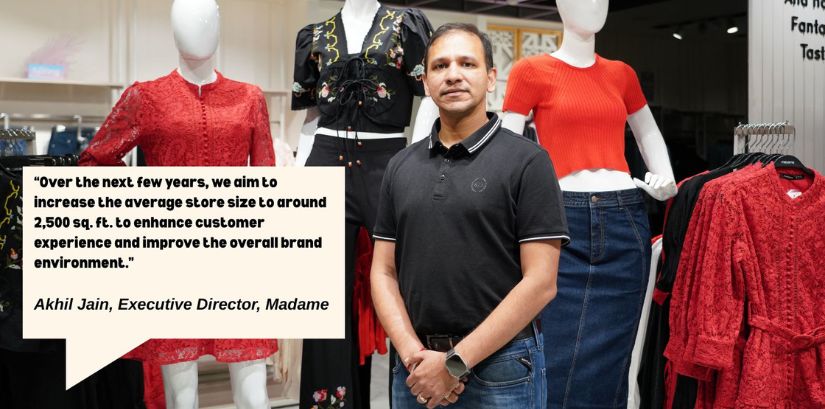- May 22, 2025
- Posted by: Renu Jangra
- Category: Business plans

“The journey of Madame has been nothing short of extraordinary,” said Akhil Jain, Executive Director, Madame. “As one of India’s oldest homegrown brands in women’s fast fashion, we are proud to be nearing three decades of serving Indian consumers. Our evolution over the years reflects not just the growth of a brand, but the transformation of Indian retail itself.”
From its early days as a manufacturer to establishing itself as a B2B retailer and eventually transitioning into a B2C brand with exclusive stores, Madame has continuously adapted to stay ahead of the curve. Today, it is a leading D2C and omnichannel brand with a robust digital presence and a loyal customer base.
Reflecting on the broader market, he noted, “Two decades ago, there were very few brands catering to the fast fashion segment. But today, with the influx of international players and the rise of strong Indian brands like ours, the competition has intensified, and that’s a good thing. It pushes everyone to be more innovative and customer-focused. Relevance is key. It’s not just about what we sell but how we sell it. Offering the right product, through the right channels, and staying closely aligned with the pulse of the consumer is what keeps a brand alive and thriving in this competitive landscape.”
Digital Surge
On the online channel front, Madame is steadily growing its digital footprint. “Currently, about 11 percent of our revenue comes from pure-play online channels, including marketplaces and our own D2C web store. When we add in online contributions from large-format retail channels, the total reaches around 12 percent,” stated Jain. “Our goal is to take this up to 20–25 percent over the next three to four years. That’s the sweet spot we’re aiming for in terms of omnichannel revenue contribution.”
The brand is present across major e-commerce platforms such as Myntra, Ajio, Tata CLiQ, and Nykaa. While marketplaces currently account for around 80 percent of the brand’s online revenue, Jain sees strong value in D2C.
“I’m proud to say that nearly 20 percent of our online revenue comes from our own web store,” he highlighted. “It’s encouraging because, despite marketplaces offering potentially better economic deals, our customers continue to engage directly with us. It shows that our brand loyalty is strong and that our web store experience resonates with them.”
Strengthening Offline Retail Footprint
Madame’s presence spans exclusive brand outlets, large-format retailers like Shoppers Stop and Lifestyle, and a wide network of trusted regional retail partners. The brand has deep-rooted relationships with prominent regional retailers across the country – from Sohum in Northeast India to Shree Shivam in Chhattisgarh, and Stanmax and Chunmun in the NCR region.
Currently, the brand operates 180 exclusive brand outlets, including a few factory sale stores. A key part of Madame’s recent strategy has been to reimagine the role of its factory sale outlets. “We’ve transformed many of these stores into a hybrid format, maintaining a 70:30 ratio – 70 percent new-season merchandise and 30 percent bargain inventory. This allows us to serve value-conscious customers without compromising on freshness or fashion relevance,” Jain explained.
The brand’s retail footprint now stretches widely across India. From Srinagar to Chhattisgarh, a Madame store is present every 40 to 50 kilometers. In the Northeast, it is present in cities like Imphal, Itanagar, and Bhimapur. While Madame has seen strong traction in North and Northeast India, penetrating southern and western markets has been a more complex journey. “Real estate entry barriers in South and West India are much higher, and the revenue dynamics differ from what we’re used to in the North. But we’ve devised a robust strategy to enter and scale in those regions as well,” he asserted.
“We’ve followed a consistent model of opening one store a month, and that’s how we’ve grown to nearly 200 exclusive brand outlets today. We plan to follow the same strategy going forward,” he added.”
Expanding Beyond Metros
Madame also has a strong presence in non-metro regions. “Being a legacy brand, our reach extends well beyond metros. Many of our MBO partners have converted their spaces into exclusive brand stores, giving us access to places like Sanjauli and Mandi in Himachal Pradesh, or even Chinchuar in Pune,” Jain shared.
Today, the brand’s presence is evenly split between metropolitan cities and Tier I, II, and III towns. “Roughly 50 percent of our footprint lies outside the major urban centers,” he noted. “This geographic balance helped us stay resilient during COVID. If we had been concentrated only in 30 metro towns, the story would have been very different.”
Diverse Product Assortment
In terms of assortment, the brand typically offers around 16 product categories with nearly 800 SKUs for the summer season. As it transitions into winter, Madame introduces an additional 6 to 7 categories focused on heavier apparel such as scarves, jackets, coats, and outerwear. Altogether, it manages close to 2,000 SKUs annually across our stores.
Madame structures its apparel into three main segments: upper wear, dresses, and bottom wear. Upper wear, which includes tops and shirts, constitutes about 48 percent of its total apparel sales. Within this segment, jersey tops, textile tops, and structured shirts perform exceptionally well. The dresses and ensembles category is also a key part of our portfolio, designed to cater to trend-forward consumers looking for elevated day-to-evening wear. For bottom wear, denim remains a core category, supported by a wide selection of trousers and track pants.
In addition to apparel, the brand has a strong and growing non-apparel (non-apps) segment, which now contributes around 48 percent of its total revenue. This includes a curated collection of handbags, sunglasses, belts, fashion accessories, and even exclusive EDPs (eau de parfums) imported from Paris, which have developed a strong customer following.
Interestingly, non-apparel performs particularly well in its airport stores. “Roughly 72 percent of footfall at airports is male, and many of them tend to pick up accessories or fragrances as gifts for family and friends,” Jain highlighted. “It’s a category that continues to evolve with every passing season, and we see a lot of potential for future growth.”
Strategic Entry into Q-Commerce
The brand is gearing up to enter the quick commerce space—but with a highly selective and strategic approach. “We’re carefully evaluating which product categories are best suited for this format,” said Jain. “Fast fashion, especially in women’s wear, doesn’t always align with the immediacy that quick commerce demands.”
Unlike groceries or daily essentials, fashion—particularly women’s fashion—is often a discretionary purchase rather than a need-based one. A woman might walk into a store, buy 10 garments, and not wear them for the next three months. Quick commerce, on the other hand, thrives on instant utility—products needed now, not later.
“Essentials like a plain spaghetti top, a white shirt, or basic trousers might work well for quick commerce, but not trend-driven fashion pieces,” he added. “It’s crucial for us to curate the right catalogue before going live.”
The brand is already catalogued with Big Basket and District, with the latter expected to launch soon. Talks with Zepto are also underway. However, the emphasis remains on getting the assortment right, rather than rushing to push the entire product range onto the platform.
Exciting Brand Collaborations
Madame actively engages in brand collaborations to keep its offerings fresh and exciting for its customers. The journey began with a collaboration featuring Tom and Jerry, which received a great response. This year, customers can look forward to a Minions-themed collection. These collaborations are often introduced as flash collections—limited-edition capsules designed to tap into pop culture moments and seasonal trends.
“These partnerships bring a unique twist to our regular line-up and create a sense of excitement and urgency,” Jain explained. “Take the Barbie trend, for instance. At one point, everyone was looking for a bright, hot pink t-shirt. I remember wearing one myself when I went to watch the Barbie movie—it was all about being part of the moment.”
Such collections not only boost engagement and footfall but also allow the brand to stay culturally relevant and appeal to younger audiences looking for a mix of fashion and fun.
What the Future Holds?
The brand’s current average store size is about 1,400 sq. ft. “Over the next few years, we aim to increase the average store size to around 2,500 sq. ft. to enhance customer experience and improve the overall brand environment,” stated Jain.
Madame is focused on consolidating its presence in existing markets while expanding into new ones—particularly in 11 state capitals where it currently has no presence. Out of its entire retail network, around 20 stores are company-owned, including airport locations, while the remaining are run through the franchise model.
“We’re also ramping up our travel retail footprint,” he added. “Our fourth airport store opened recently at Srinagar, and these travel locations have performed exceptionally well for us.”

